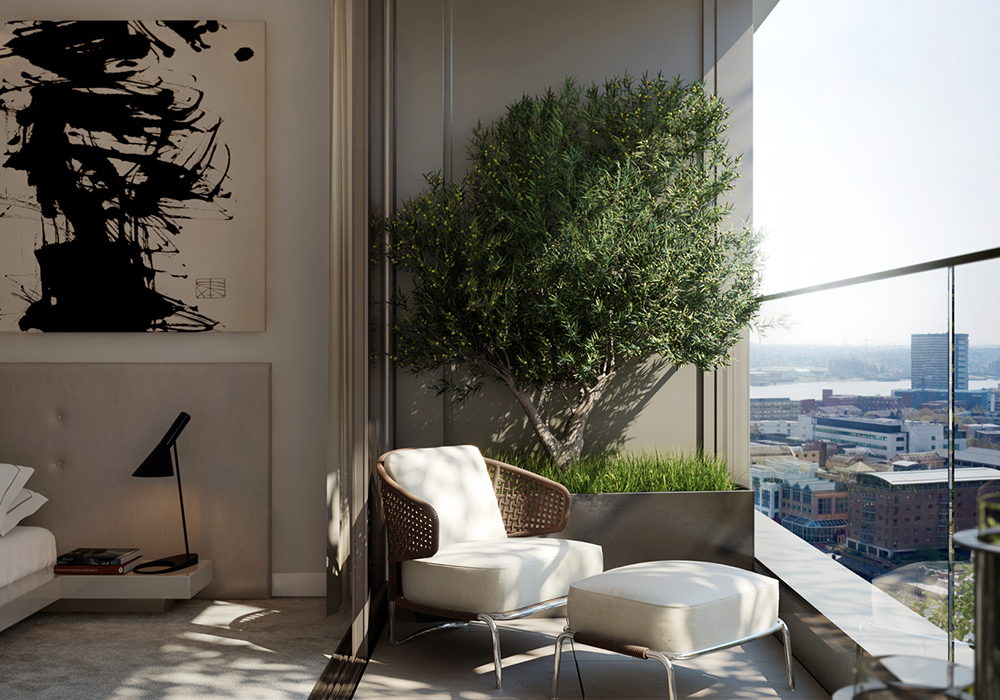
Sold on Sustainability
06.03.20The way in which people live in the capital is changing, with a shift towards sustainable design and build taking centre stage. Lucinda Steel joins the green city rat race and asks is there a finishing line agenda?
‘Green’ is a buzzword in the construction industry of late. Pressure on architects and builders to meet new government guidelines and politically correct manoeuvres towards being ‘kinder’ to the planet, means that all sectors feeding into the property industry have a heightened-awareness of the need to incorporate sustainability.
As the UK’s most populous and built up city, London is a prime candidate for responsible construction, and predicted, in the coming years, to throw off its ‘Big Smoke’ moniker.
The white paper, Top 10 Cities for Global Green Buildings, by market strategist Solidance, cites city-wide performance goals in London as a global leader in going green, primarily due to mixed-use development initiatives in train to resolve the effects of urbanisation on the environment.
The government’s stringently set national targets for example, require all new homes built and all new non-domestic buildings from 2019 to be carbon-zero. Developers of new buildings also have to comply with the mayor’s energy policies.
But while the London Green Fund has set up an Urban Development Fund worth $50 million for investment in energy efficient products, the passing of the Housing and Planning Act sees the scrapping of a zero-carbon homes commitment.
Adds Julie Hirigoyen, Chief Executive of the UK Green Building Council: “We still have a long way to go on the sustainable build journey. The white paper cites benefits from “high yield of green buildings in the city, which can be linked to the fact that the United Kingdom was the first country ever to introduce a green building certification system, for example, BREAAM, the world’s leading sustainability assessment method for masterplan developments.
There’s no question sustainability is vital for construction and refurbishment in London with multiple benefits even beyond reducing carbon footprints, but in the green building race, it’s also vital to keep our sights on the bigger picture of living in a sustainable, efficient and low-consumption city. That’s fundamentally more important than how many buildings can be labelled as 'green’.”
Green Home Heroes
John O’Brien - chartered builder and associate director for Construction Innovation at Building Research Establishment (BRE), which provides training, publications and advice to enable construction professionals to work better and more intelligently.
“With more people looking to make the move into the capital, a focus on adapting older properties such as mansion blocks is a rich residential vein to tap into. This type of building has a good quality of space, and when renovated and landscaped correctly, they can add a lot of value.
Innovation is also key to sustainable living. As such, developers are looking to green power sources to run properties. Landmark developments, such as in Battersea, capture heat from water using water source heat pumps. They work on a similar principal to air and ground source heat pumps and are being looked at as an alternative to electricity and gas by using existing water sources to heat buildings. In fact, heat pumps in general are being used more across London. They’re a game-changer in smart build.”
Oliver Heath - an industry recognised expert in the field of sustainable architectural and interior design, Oliver also has a strong television background featuring in widely broadcasted programmes on BBC, ITV, Channel 4 and the Discovery Channel.
“I relate to two types of sustainability – traditional, which focuses on aspects such as carbon emissions and waste, and human which focuses on people and the essentials they need in a home to be happy. I’ve been working on traditional sustainability since 1998 and in the last 10 years have embraced the human aspect.
We use biophilic design and extol the positive affect it his on clients. We always start by assessing the project. What natural resources are there in the local area? How do we incorporate natural light and nature? These considerations are much harder to incorporate in urban areas in London but are vitally important in high-stress areas.
Biophilic design has three core principles – the first is a direct connection to nature which focuses on adding plant life internally and externally along with good air quality, a focus on ventilation to help remove negative toxins from the air, as well as aspects such as water quality, incorporating water filtration systems.
There’s also the indirect connection focusing on the actual design of the space and making sure the colours, textures and materials have a connection to nature. Buildings should allow people to be active – this can be simple things such as putting stairs where a lift would normally be.
Finally, human spatial response tackles the themes of the rooms in the house – it’s important to have an inspiring space, but we also need somewhere to relax for some vital me-time. A space needs to suggest that life will flourish.”
David Elliot - head of the charity Trees for Cities, David is also a member of the London Sustainable Development Commission, which provides advice to London’s Mayor Sadiq Khan on helping make the city more sustainable as it develops and grows.
“By 2030, London’s population is projected to reach 10 million. For the UK’s capital, already one of the busiest cities in the world, this means even more pressure – particularly on its green spaces.
The good news is that London is on course to becoming one of the greenest and most sustainable cities on Earth, thanks to a raft of new initiatives. In fact, as of this year, London will become the first-ever National Park City – a project that will push for half of the city area to consist of green and blue spaces – parks and bodies of water – by 2050. The figure is currently at 47%. Support for the campaign has been so successful that organisers are now launching an initiative to also plant nine million wildflowers across the city.
The reality now is that there is more understanding that green space and access to the outdoors results in a high quality of life. There’s a huge amount of inequality in London and there are enormous divisions. That’s the same with green spaces, too. Many of the most socially deprived areas are the most green-deprived. Much of this new development needs to be around areas of social deprivation.
Another key issue is green financing and creating a new clean tech hub within London. A green Silicon Valley will be such a key part of the sustainable economy. The millennials have taken a massive step forward in terms of their awareness and that’s a real encouragement for the future, but continued investment is key.”
BOX OUT Pioneering Approach
The Eco World International Group has been creating award-winning developments in the UK since 2015.
Each of their developments offers a new communal way to experience London life. From Aberfeldy Village’s prime location in East India Docks to The Claves’ tranquil gardens at Millbrook Park, the company offers a diverse variety of sustainable-build homes in the capital.
Surrounded by well-kept parks, the tropical gardens of Kew and the River Thames, Verdo is not just a selection of beautiful new homes, but the start of an exciting regeneration and a whole new neighbourhood.
With the Royal Botanic Gardens, Kew Village and Chiswick close by – plus outstanding rail and road connections – the projects comprises one, two and three bedrooms, as well as Verdo Kew Bridge’s first set of studio apartments, ranging from 538 square feet to 1,066 square feet in size. Each of the airy, light-filled apartments benefit from tall windows and elegant balconies, with quality finishes used throughout. Prices start from £350,000.www.ecoworldlondon.com
Abode Affiliates
COPYRIGHT © Abode2 2012-2025






















































































































































































































